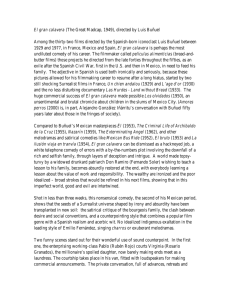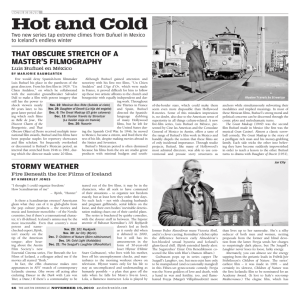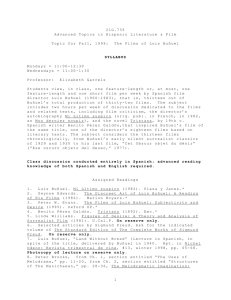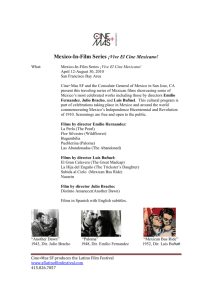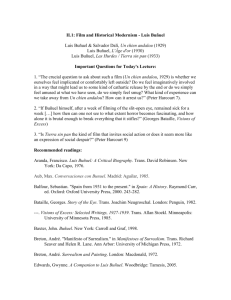1 2 1 G . 7 3 5
advertisement
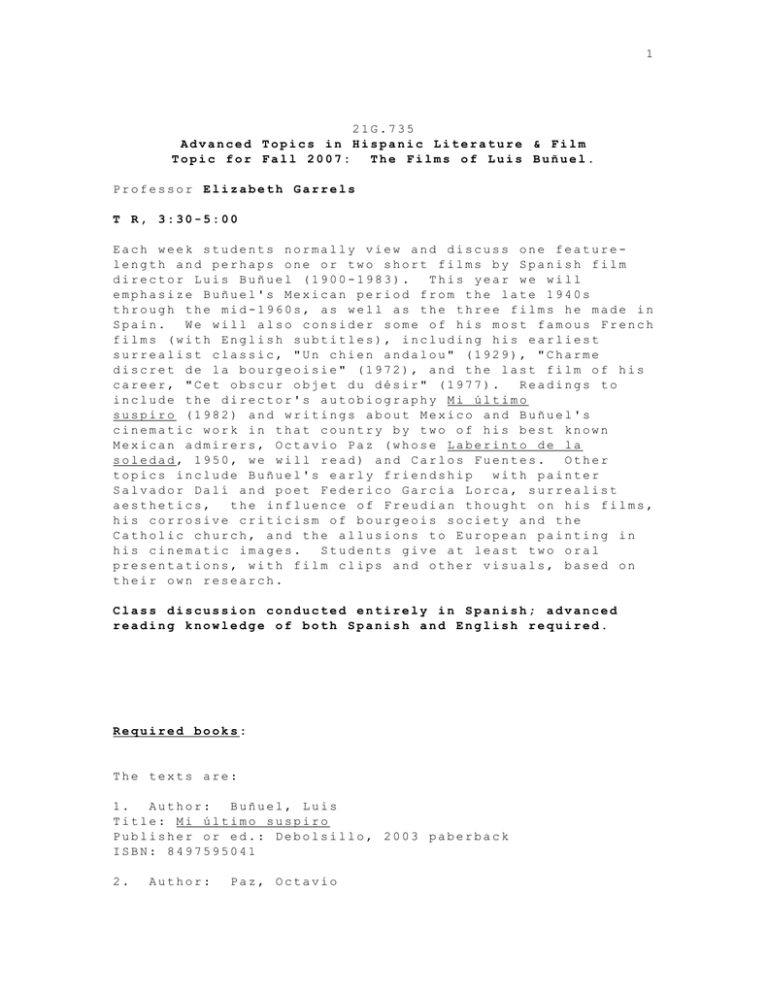
1 21G.735 Advanced Topics in Hispanic Literature & Film Topic for Fall 2007: The Films of Luis Buñuel. Professor Elizabeth Garrels T R, 3:30-5:00 Each week students normally view and discuss one featurelength and perhaps one or two short films by Spanish film director Luis Buñuel (1900-1983). This year we will emphasize Buñuel's Mexican period from the late 1940s through the mid-1960s, as well as the three films he made in Spain. We will also consider some of his most famous French films (with English subtitles), including his earliest surrealist classic, "Un chien andalou" (1929), "Charme discret de la bourgeoisie" (1972), and the last film of his career, "Cet obscur objet du désir" (1977). Readings to include the director's autobiography Mi último suspiro (1982) and writings about Mexico and Buñuel's cinematic work in that country by two of his best known Mexican admirers, Octavio Paz (whose Laberinto de la soledad, 1950, we will read) and Carlos Fuentes. Other topics include Buñuel's early friendship with painter Salvador Dalí and poet Federico García Lorca, surrealist aesthetics, the influence of Freudian thought on his films, his corrosive criticism of bourgeois society and the Catholic church, and the allusions to European painting in his cinematic images. Students give at least two oral presentations, with film clips and other visuals, based on their own research. Class discussion conducted entirely in Spanish; advanced reading knowledge of both Spanish and English required. Required books: The texts are: 1. Author: Buñuel, Luis Title: Mi último suspiro Publisher or ed.: Debolsillo, 2003 paberback ISBN: 8497595041 2. Author: Paz, Octavio 2 Title: El laberinto de la soledad Publisher or ed.: Cátedra - Letras Hispánicas, 346 ISBN: 8437611687 Unless otherwise announced, all films will be viewed in the LLARC: Our films will have scheduled viewing times in the LLARC. You can see the film on the ODD hour anytime the LLARC is open. So if you look at the LLARC's schedule on its webpage, this means that Monday - Thursday, our films will show at 9 and 11 a.m., and 1,3,5,7, and 9 p.m. Friday, the last showing is at 1 pm (because the LLARC closes at 3), and Sunday, the first showing is at 3 p.m. (when the LLARC opens). This way you will know exactly when you can expect to pick up the movie to begin viewing it in one of the LLARC's studios. If you want to start viewing the film before the scheduled times, and no one is watching it, you can start when you want, but if someone comes to watch the film at the ODD hour, you will have to start the film over again, in a studio, at that time. The studios accommodate up to ten students at any one time. You might like to arrange to see the film with other classmates and discuss it with them afterwards. Books on Reserve and photocopies: I have submitted a long list of books to be placed on reserve for this subject. At the beginning of the semester, the Reserve may still have only a few titles on its web page. (You can consult 21*.735's Reserve list by clicking on CLASS RESERVES at the top of the search page for Barton.) Be patient. I have asked the librarians to start placing titles that you may wish to consult during the first three weeks of class, and it may take them up to a week to put these on. There will also be a certain number of photocopies that will be distributed in class. You will be charged for these at the end of the semester. Films to be discussed Week One 1. Thurs., Sept. 6 - Introduction to subject: Brief introductory lecture on Surrealism and the friendship of Luis Buñuel, Salvador Dalí, and Federico García Lorca in the 1920s. -Review terminology useful in discussing Buñuel’s films. -View in class: “Un Chien andalou” (Spanish title: "Un perro andaluz," English title: "An Andalusian Dog") (Paris, 1929, 16 minutes), by Luis Buñuel and Salvador Dalí. (LLARC # SP 144) 3 Week Two 2. Tues., Sept. 11 - View slides and web images of surrealist and other paintings. (If students wish to view more early paintings by Dalí, that is, up until the mid1930's, when his friendship with Buñuel ended, the most complete website organized chronologically I have found is <http://www.abcgallery.com/D/dali/dali.html>.) -Continue discussing “Un Chien andalou.” Since last class, students should have seen "Un Chien andalou" on their own several times. Also, you should come to class having read the filmscript in Spanish for "Un perro andaluz" (photocopy). -Also read two poems by Federico García Lorca (1898-1936): "Vuelta de paseo" and "Oda a Salvador Dalí (photocopies) -View in class: "Las Hurdes"(English title: “Land Without Bread”) (Spain, 1932, 27 minutes) (LLARC #SP 144) - Over the weekend, students are expected to have read Chapters 1-7, "Memoria," "Recuerdos de la Edad Media," "Los tambores de Calanda," "Zaragoza," "Los recuerdos de Conchita," "Los placeres de aquí abajo," and "Madrid: La Residencia de Estudiantes (1917-1925)" (pp. 9-89) en Buñuel, Mi último suspiro. For all assignments from Mi último suspiro, take reading notes in Spanish and send them to me by e-mail as a Word attachment. These notes should record (and at least in some cases, comment on) those instances in the autobiography where Buñuel expresses opinions on politics, religion, freedom, sexuality, dreams and the irrational, and art and aesthetics. Feel free to add other categories if you wish. Also, there are a lot of cultural allusions in Buñuel's book, ie. to names and historical events. When you don't recognize a name or an event, write it in you notes, and use the web to quickly identify at least five of the allusions you didn't recognize. (Give web sources, and use quotation marks if you copy text. Please don't send me more than 100 words per identification, although you are free to print out more and keep it for yourself. I accept Wikipedia for this exercise; these identifications can be in Spanish or in English.) PLEASE SEND ME THESE NOTES BY 9:00 A.M. ON THE DAY OF THE CLASS. -Students should also have visited the website <http://cvc.cervantes.es/actcult/bunuel/indice.htm > and on the main page, next to "Indice," clicked on "Su obra y su tiempo." Take some time to see what the website on Buñuel has to offer. I especially recommend the section 4 "Obsesiones" and the "Filmografía." From now on, you will be responsible for consulting this website on your own. -Also read: Sigmund Freud, "E. Representation By Symbols in Dreams--Some Further Typical Dreams," from "VI. The Dream Work," in The Interpretation of Dreams (photocopy from Avon ed., pp.385-95). (Freud's book was originally published in 1900, but the material in this particular section started to appear only in the 2nd. and 3rd. editions of 1909 and 1911. The text of the Avon edition [1965] reproduces a later edition and incorporates changes added in editions subsequent to the third.) [An early form of the material contained in "E, VI" from the 1911 ed. of The Interpretation of Dreams is available for free on the web at <http://www.psywww.com/books/interp/chap06e.htm> You may wish to consult this site (or Vols. IV and V of The Standard Edition of The Complete Psychological Works of Sigmund Freud [On reserve]) to read some of the descriptions of particular dreams that, in the handout of the Avon ed., only just begin on p. 395 but are not reproduced. The titles of these include: "A Hat as a Symbol of a Man (or of Male Genitals)," "'A 'Little One' as the Genital Organ-'Being Run Over' as a Symbol of Sexual Intercourse," "The Genitals Represented by Buildings, Stairs and Shafts," "The Male Organ Represented by Persons and the Female Organ by a Landscape," "A Staircase Dream," "The Feeling of Reality and the Representation of Repetition," "The Question of Symbolism in the Dreams of Normal Persons."] Highly recommended: Two articles in English, both accessible and relatively jargon-free, which interpret "Un perro andaluz" in relation to Freud's theories on dreams and sexuality, but which attribute significantly different narratives to the film: -The more traditional of the two, and the essay to read if you only have time to read one, is: Chapter 1, "Un chien andalou," in Gwynne Edwards, The Discreet Art of Luis Buñuel (On reserve). This book is written for a broad audience; it is helpful, but sometimes describes certain details in the films inaccurately. -The second article interprets the film as a work that expresses the concerns of Salvador Dalí more than those of Buñuel. It discusses the films in relation to Dalí's paintings and writings at the time, and comes up with a reading of the film's discourse on sexuality that is far afield from the fundamentally heterosexual discourse that Edwards sees in the film. You can access this article electronically through Vera on the MIT Library Webpage. On the Vera page, in the box that corresponds to "Find titles of journals or databases" on the left of the screen, write "Diacritics." Then click "Display list." Click on the first listing for this journal that comes up. Look for: 5 Ignacio Javier López, "Film, Freud, and Paranoia: Dalí and the Representation of Male Desire in An Andalusian Dog," Diacritics - Volume 31, Number 2, Summer 2001, pp. 35-48. 3. Thurs., Sept. 13 (Rosh Hashanah) - View before class "Los olvidados" (English title: “The Young and the Damned”) (Mexico, 1950, 88 minutes). (LLARC #SP 116). (When in the LLARC, if you don't know how to make a film clip--to copy a single scene from a film that you can then watch on your own and manipulate, please sign up for instruction on a list for our class that you will find at the front desk.) -Continue discussing "Las Hurdes." (Use the photocopy of the film's shot sequence to help organize your thoughts about the film.) Discuss two texts by Buñuel: "Tierra sin pan" and "El cine, instrumento de poesía." (photocopies). Also, the filmscript for "Las Hurdes" is available in Spanish in Buñuel, Escritos de Luis Buñuel (On reserve). Week Three 4. Tues., Sept. 18 - Continue discussing "Los olvidados." -Read: Edwards, Chapter 3, "'Los olvidados' (The Young and The Damned)," The Discreet Art of Luis Buñuel: A Reading of His Films (pp. 89-111) (On reserve). -Peter William Evans, Chapter 2, "Family Romances: Buñuel's Mexican Melodramas," only first pages up to Section 1 (pp.36-43), and all of Section 3 "Los olvidados and the 'Uncanny'" (pp. 72-89), from The Films of Luis Buñuel: Subjectivity and Desire (On reserve). -Octavio Paz, Chapters I, II, and IV ("El pachuco y otros extremos," "Máscaras mexicanas," "Los hijos de la Malinche," in El laberinto de la soledad (orig. publ. 1950). -Ernesto R. Acevedo-Muñoz, Chapter 3 ("Los Olvidados and the Crisis of Mexican Cinema," pp. 57-79), in Buñuel and Mexico: The Crisis of National Cinema (On reserve). -Carta de Octavio Paz a Luis Buñuel, 11 abril 1951 <http://cvc.cervantes.es/actcult/bunuel/escritos/paz.htm> 5. Thurs., Sept. 20 - View before class “Le Charme Discret de la Bourgeoisie” (Spanish title = El discreto encanto de la burguesía," English title = “The Discreet Charm of the Bourgeoisie”) (France/Spain/Italy, 1972, 105 minutes) (LLARC # FR 185). -Read: Freud, “Family Romances” (1909), The Standard Edition, Vol. IX, 236-41 (On reserve). -In class, after discussing the film at length, students will spend ten minutes brainstorming on five good scenes 6 that deserve further study; then they will each choose one scene to develop in an oral report with another student. These reports will be presented to the class on Tues., Sept. 25. Instructions for this report are: Together with another student, choose a short scene (max. 4 mins.) from "Le Charme Discret de la Bourgeoisie." Make a copy (film clip) of it, show it to the class, and discuss the scene in terms of 1) its filmic construction and 2) its relevance with regard to the film’s narrative as a whole. No repetitions of scenes, please; each pair of students must consult with the rest of the class ahead of time to avoid selecting another pair's scene. Each report = maximum of 10 minutes total, including film clip. Week Four 6. Tues., Sept. 25 - Continue discussing "Le Charme Discret." -Student oral presentations on "Le Charme Discret." (50 minutes, plus q&a) -Read: Chapter 9 in Edwards, The Discreet Art, and Chapter 1 in Evans, The Films of Luis Buñuel, both of which deal with "Le Charme Discret" (On reserve). -Bruce Babington and Peter William Evans, "The Life of The Interior: Dreams in The Films of Luis Buñuel," Critical Quarterly, vol 27, no. 4, winter 1985. 5-20 (On reserve). 7. Thurs., Sept. 27 - View before class "Susana" (English title: "The Devil and the Flesh") (México, 1950, 80 minutes) (LLARC # SP 163). Read: Evans, Chapter 2, Section 1 ("Susana: The Daughter's Seduction"), The Films of Luis Buñuel, pp. 44-60 (On reserve). Week Five 8. Tues., Oct. 2 - Continue discussing "Susana." -Over the weekend, students should have read Chapters 8-10, "París (1925-1929)," "Sueños y ensueños," "El surrealismo (1929-1933)" (pp. 89-143), and Chapters 11-14, "América," "España y Francia (1931-1936),"and "Amores, amores," and ""La guerra de España (1936-1939)" (pp. 145-99), in Buñuel, Mi último suspiro. Take reading notes in Spanish and send them to me by e-mail as a Word attachment, by 9:00 a.m., 10/02/07. -Read: Acevedo-Muñóz, Chapter 4 ("Genre, Women, Narrative"), pp. 80-93 (On Reserve). 7 - By today, students need to have informed the professor by e-mail of their film choice for their 10-page paper, due the last day of class. Students can choose among the following eleven films: "Los olvidados," "Susana," "Una mujer sin amor," "El bruto," "El," "Ensayo de un crimen," "Nazarín," "Viridiana," "Tristana," "Simón del Desierto," and "El ángel exterminador." In order to familiarize yourselves with the arguments of the films you haven't seen yet, go to Hayden and consult Agustín Sánchez Vidal, El mundo de Luis Buñuel (On Reserve). Go to the "Filmografía" on p. 281, and then read the resúmenes argumentales for these films. The summaries appear chronologically, according to the films' release dates. Individual oral presentations on your work in progress begin on Thursday, Nov. 8. Each presentation will be a maximum of 20 minutes, with a minimum of 5 minutes q&a. 9. Thurs., Oct. 4 - View before class "Una mujer sin amor" (English title: "A Loveless Woman") (México, 1951, 90 minutes) (LLARC # 181). -Read: Evans, Ch. 2.2 ("Una mujer sin amor and Romantic Love"), The Films of Luis Buñuel, pp. 60-72. Week Six Tues., Oct. 9 (Columbus Day, no classes) 10. Thurs., Oct. 11 - View before class "El bruto" (English title: "The Brute") (México, 1952, 83 minutes) (LLARC # 199). Discuss Peter Brooks (handout) on melodrama. -Read: Acevedo-Muñóz, Chapter 6 ("Masculinity and Class Conflict: Buñuel's Macho-Dramas"), pp. 124-32 (On Reserve). -Read: Chapters 16 and 17, "De nuevo América," "Hollywood, continuación y fin"(pp. 207-29) and Chs. 18-21 (pp. 231303), in Buñuel, Mi último suspiro. Take reading notes in Spanish and send them to me by e-mail as a Word attachment, by 9:00 a.m. on 10/11/07. Week Seven 11. Tues., Oct. 16 - View before class "El" (English title: "He") (México, 1952, 91 minutes) (SP#195). -Read: Evans, Chapter 3, up until Section 1, and all of Section 2 (pp. 90-97, 111-24) (On reserve). -Read: Freud, “Fetishism” (1927), The Standard Edition, Vol. XXI, pp. 149-57 (Electronic reserve, under Materials at class site). 12. Thurs., Oct. 18 - View before class "Ensayo de un crimen" o "La vida criminal de Archibaldo de la Cruz" 8 (English title: "The Criminal Life of Archibaldo de la Cruz") (México: 1955, 91 minutes). (SP # 137) (This version has no English sub-titles; LLARC also has a DVD, with subtitles.) Discuss "Ensayo," and continue discussing "El." -Read: Evans, Chapter 3, Section 1 ("Ensayo de un crimen and Oedipality"), pp. 97-111 (On reserve). Week Eight 13. Tues., Oct. 23 - - View before class "Nazarín" (Mexico, 1958, 97 minutes) (LLARC # SP 136 and SP 136B). Discuss "Nazarín," and continue discussing "Ensayo." -Read: Edwards, Chapter 4 of The Discreet Art, pp. 115-39 (On reserve). -Read: John Berger, Chapter 3 of Ways of Seeing (1972), pp. 45-64 (On reserve). 14. Thurs., Oct. 25 - Conclude discussions of "El," "Ensayo, and "Nazarín." -Read: Octavio Paz, "El cine filosófico de Buñuel," Corriente alterna, 1967, pp. 113-18. (photocopy) -Read: Carlos Fuentes, "The discreet charm of Luis Buñuel: Spain, Catholicism, surrealism, anarchism," The New York Times Magazine, March 11, 1973. (Electronic reserve, under Materials at class site) Week Nine 15. Tues., Oct. 30 - View before class “Viridiana” (Spain/Mexico, 1961, 90 minutes). (SP #008). -At the website <http://cvc.cervantes.es/actcult/bunuel>, on the main page, next to "Indice," click on "Su obra y su tiempo." View and read the contents of the seventh title, "El éxito de una película prohibida: Viridiana (1961)" (plus 4 image pages). -Read: Edwards, Chapter 5 of The Discreet Art, pp. 143-67 (On reserve). -Read: Ch. 15 ("Ateo gracias a Dios"), pp. 201-06, in Buñuel, Mi último suspiro. Take reading notes in Spanish and send them to me by e-mail as a Word attachment, by 9:00 a.m., 11/01/07. 16. Thurs., Nov. 1 - - View before class “Tristana” (Spain/France/Italy, 1970, 105 minutes). (SP#152). Discuss "Tristana," and continue discussing "Viridiana." 9 -Read: Freud, "Lecture 33: The Psychology of Women," from New Introductory Lectures on Psycho-Analysis (1932) (handout; also on reserve in Vol. XXII of The Standard Ed.) Week Ten 17. Tues., Nov. 6 - Continue discussing "Viridiana" and "Tristana." -Read: Excerpts from Benito Pérez Galdós's novel Tristana (1892). (TBA) -Read: Jo Labanyi, "Fetishism and the Problem of Sexual Difference in Buñuel's Tristana (1970)," in Peter William Evans, ed., Spanish Cinema: The Auteurist Tradition. New York: Oxford University Press, 1999, rpt. 2003, pp. 76-92 (On reserve). -Read: Pierre Vilar, Ch. 5, Sections I ("The Crisis of the Monarchy [1917-31]") and II ("The Republic [1931-36]), in Spain: A Brief History (1967), pp. 85-105 (On reserve). 18. Thurs., Nov. 8 - View before class “El ángel exterminador” (Mexico, 1962, 95 minutes). (SP #115) -Read: Edwards, Chapter 6 of The Discreet Art, pp. 171-93 (On reserve). Week Eleven 19. Tues., Nov. 13 - "Simón del desierto" (English title: "Simon of the Desert") (México, 1965, 42 minutes) (LLARC # SP 201). [SEE IN CLASS] - Read: Freud, “The Uncanny” (1919, the entire article), The Standard Edition, Vol. XVII, pp. 218-52 (Electronic reserve, under Materials, at class site). 20. Thurs., Nov. 15 - View before class “Cet obscur objet du désir” (Spanish title: "Ese oscuro objeto del deseo," English title: "That Obscure Object of Desire")(France, 1977, 103 minutes). (FR #247) -Read: Evans, Chapter 3, Section 3 ("Cet obscur objet du désir and Sado-masochism"); Conclusion (pp. 124-33, 173-75) (On reserve). Week Twelve 21. Tues., Nov. 20 - Continue discussing "El ángel exterminador," "Simón del desierto," and "Ese oscuro objeto del deseo." Thurs., Nov. 22 - Thanksgiving __ Week Thirteen 10 22. Tues., Nov. 27 - 2 individual oral presentations (50 minutes plus) 23. Thurs., Nov. 29 - 2 individual oral presentations (50 minutes plus) Week Fourteen 24. Tues., Dec. 4 - 2 individual oral presentations (50 minutes plus) 25. Thurs., Dec. 6 - 2 individual oral presentations (50 minutes plus) Week Fifteen 26. Tues., Dec. 11 - Discuss “Un Chien andalou” (Paris, 1929, 16 minutes), by Luis Buñuel and Salvador Dalí. (LLARC # SP 144) [SEE FILM AGAIN IN CLASS]. Do class evaluation. -At beginning of class, hand in 10-page research paper (double-spaced, 250 words per page, and written in Spanish). You can refer to specific still shots in your paper if you wish. Numbered stills can be included as an addendum to your paper, before the "Bibliografía." See "Plagiarism" statement below. DETERMINATION OF FINAL GRADE: 1. Attendance* and quantity and quality of active participation in class discussions = 35% 2. Reading notes on Mi último suspiro = 20% 3. First oral presentation ("Le Charme") = 10% 4. Oral report on 10 pp. paper = 10% 5. 10 pp. paper = 25% total = 100% *An unexcused absence for more than one class will negatively affect your final grade. PLAGIARISM: According to Webster's New Collegiate Dictionary, to plagiarize is "to steal and pass off (the ideas or words of another) as one's own: use (a created production) without crediting the source ~vi: to commit literary theft: present as new and original an idea or product derived from an existing source." This includes copying something out of a book, newspaper, journal or any other printed source, as well as electronic resources such as the World Wide Web without the appropriate acknowledgement. According to this definition, plagiarism would also include the following: 11 using material created by another student at your school or anywhere else and passing it off as your own (with or without their consent). using a paper-writing "service" which offers to sell written papers for a fee. translations (with or without translation software) of texts from other languages and submitting them as your own work. Plagiarism is an extremely serious academic offence. Students should be aware that they will be severely penalized if caught engaging in any form of plagiarism. If you have any questions or doubts about how to document the sources of your ideas, please consult your instructor. For further information you can consult the MIT Libraries: What is plagiarism and how to avoid it. MIT OpenCourseWare http://ocw.mit.edu 21G.735 Advanced Topics in Hispanic Literature and Film: The Films of Luis Buñuel Fall 2013 For information about citing these materials or our Terms of Use, visit: http://ocw.mit.edu/terms.
